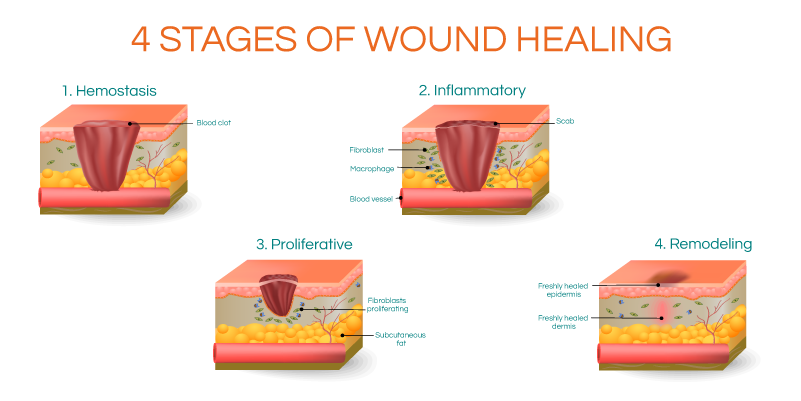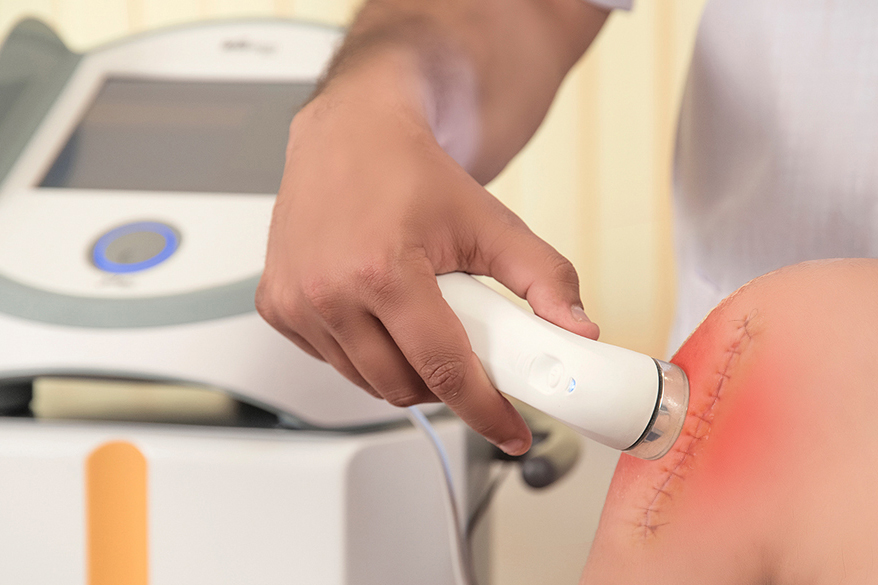Overview
The significant rise in the number diabetic patients and acute wound cases across the globe has led to spike in demand for wound healing medical devices. The global wound care devices market size was valued at $2.19 Bn in 2019 & is projected to reach $3.13 Bn by 2027, at a CAGR of 4.6% in the forecast period. Investing in wound management devices at this stage can multiply your chances of boosting ROI and expanding your product portfolio.
To begin with let’s dive deeper into the process of wound healing and latest technologies promoting accelerated healing. Firstly, let’s understand the process of wound healing to understand how does advanced technology aid in faster wound healing.
The process of wound healing: Science behind

Image: physio-pedia.com
Wound healing is a cascaded process. The process comprises of several stages including Hemostasis, clotting, proliferation and recovery.
- Hemostasis involves blood vessel constriction
- The vessels collide with one another and promote clotting
- The white blood cells are activated and cells surrounding the wound experience inflammation, heat, pain and swelling
- Once the clotting is complete, granulation comes into picture. The extracellular matrix and collagen together replace the wound area with fresh tissue. This phase is marked by conversion of the pinkish wound with granular red matrix
This entire process on its own is slow and timelines vary from one individual to another depending on the individual’s metabolism. Different external factors also impact the time of wound recovery. To address the same, numerous advanced technologies can be of great help.
Latest Technologies in Wound Healing Devices
1. Biophotonic therapy, LED Therapy for wound healing
The application of Low Level Laser or Biophotons around the wound area eliminates viruses, bacteria, molds, fungi and more. This accelerates natural healing process. Specific waveform has specific application and effect.
RED: 635 nm
- Increase in ATP Production
- Immunoglobulin production enhancement
- Increase in oxygen flow in the wound
- Nerves & muscle calming
- Metabolism enhancement in body
GREEN: 532 nm
- Improvement of function and cell elasticity of erythrocytes
- Enhanced ATPase activity
- Activated repair process
BLUE: 405 & 407 nm
- Telomerase activation for anti-ageing
- Wound repair & healing
- Cholestrol, triglyceride and bilirubin reduction
- Wound repair
2. Electrotherapy for wound healing
The entire body comprises of cells. Cells have plasma membrane across which the difference of potential causes movement from inside & outside. When the skin is wounded, cells lose their potential that eventually cause inhibited healing. Electrotherapy aids in restoring the endogenous membrane potential. The application of currents of different intensities promote Galvanotaxis. Galvanotaxis refers to the ability of the keratinocyte clusters to guide the electrical current to promote wound repair. The application of electric currents directs fibroblast migration & re-epithelization for fast recovery.

3. Ultrasound Wound Repair Treatment
Therapeutic ultrasound causes deep healing of tissues. The heat promotes proper blood circulation and restoration of damaged tissues in the wound area. In general, 3MHz of ultrasound with intensity at 0.3-0.5 W/cm squared is applied on the affected area (subject to change as per the device brand and expected functionalities). The applicator head of the Therapeutic ultrasound is usually 2 times the size of the treated area. During application the heating effect causes cell proliferation and collagen repair for faster wound healing. The technology is also helpful for adipose tissue disruption for fat breaking. The technology (Ultrasound Cavitation) can be customized for sculpting and toning purposes as well.

4. Laser Technology
Wound provides an easy way for the bacteria to enter into the skin. Quicker healing needs a solution to kill the bacteria around the wound. Application of Laser can significantly inhibit the bacterial growth around the wound. This facilitates easy healing and quick recovery. The application of Low Level Laser stimulates ATP production in the Mitochondria of the cell to facilitate growth of Macrophages, Fibroblasts, Endotheliocytes, Keratinocytes, Mast cells & Collagen. The technology LLLT is also used in pain management, cellulite reduction and hair re-growth.

Expand your product portfolio with wound healing devices from Johari Digital Healthcare Ltd.
Are you looking for a manufacturing partner to accelerate your wound healing device to market? Schedule a call with us to explore our manufacturing services to expand your product portfolio with advanced wound healing devices.

